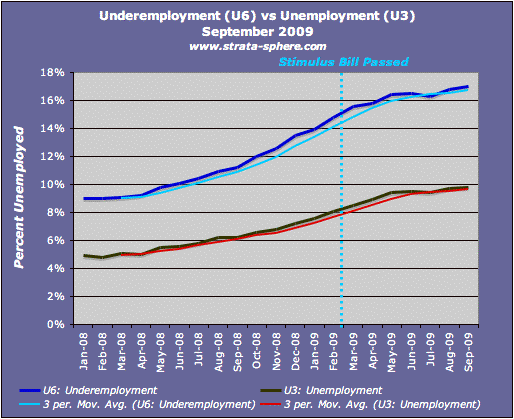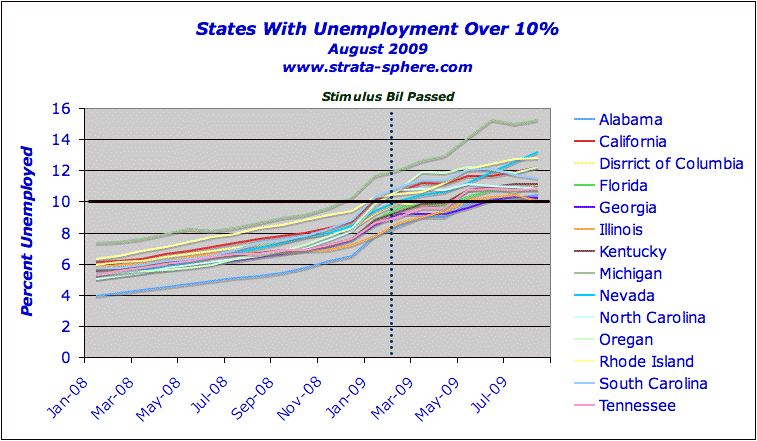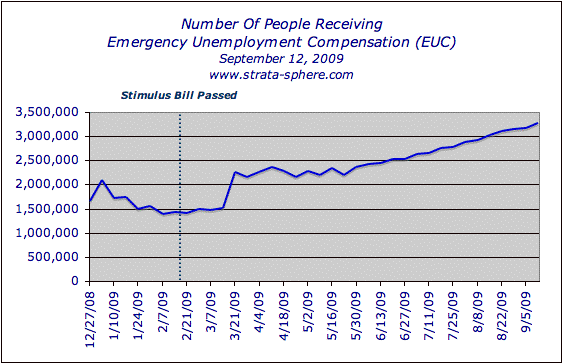Oct 12 2009
Economic Woes Extend Up The Economic Ladder
Let’s just take off the partisan glasses for a few moments and note that current economic trouble actually began years ago with a terrible idea to risk the stability of the real estate market (what could go wrong, they can’t make more land?) by loosening all the controls for ensuring people who buy can afford what they are buying.
This one crazy fantasy – that everyone should own their home no matter their financial status – allowed millions and millions of people to buy property they were inevitably going to default on. Instead of providing a leg up to those on the lower rungs of the economic latter, the whacky scheme lined the pockets of a lot of power players who raked in billions on shaky mortgages.
But it was also a cancer, let in to feed on the foundation of our economy. Over the years more and more mortgage failures hit, consuming the reserves there were to weather such storms. Until finally, the failure rate of mortgages caused the collapse of some of the biggest financial institutions, drying up credit, panicking every sector, and bringing on the Great Recession of 2008.
This is the true history the Political Industrial Complex (which encompasses politicians, lobbyists, power brokers, media allies, etc) do not want the public to see. And only occasionally does it peek out from stories on the growing economic tsunami this one idiotic idea caused this nation – and this world.
Worse, it seems the risky scheme is not done claiming victims, as it is now starting to gnaw at the upper rungs of our economy:
About 30% of foreclosures in June involved homes in the top third of local housing values, up from 16% when the foreclosure crisis began three years ago, according to new data from real-estate Web site Zillow.com.
This one sentence is packed full of important details. First off, the foreclosure crisis is admitted to have started 3 years ago (at least). That is a very important bit of news, since that clearly indicates that large scale real estate foreclosures were really the first domino to bring on this massively deep and long recession.
It was not deficit spending, or wars in Iraq and Afghanistan, or low taxes, or even high taxes. It was a disastrous scheme to allow millions of people buy up homes they could not possibly afford, which saddled are banking system with billions in risky assets. These buyers started to fail in droves and consumed all the monetary reserves in place to deal with foreclosures. Reserves established assuming only solid buyers would be allowed the right to ‘own’ a home (which in reality is the responsibility to be financially stable enough to pay off the home over 30 years).
The next sentence proves this point:
The bottom one-third of housing markets, by home value, now account for 35% of foreclosures, down from 55% in 2006.
So, at the ‘start the cancer first ate through the sub prime markets where it got its foot hold, but has since moved upward to the middle and up class markets. There is no stronger indicator of where this economic mess all started.
And if people think we are ‘stimulating’ our way out of this mess, then think again:
The report shows that foreclosures, after declining earlier this year, began to accelerate in the late spring and that more expensive homes have more recently accounted for a growing share of all foreclosures. “The slope of that curve in recent months is much sharper than it was recently,” said Stan Humphries, chief economist for Zillow. Rising foreclosures among more-expensive homes could create added pressure for a housing market that has shown signs of stabilizing in recent months as sales of lower-priced homes pick up.
Note how the foreclosures began to accelerate again AFTER the so called stimulus bill passed. At this stage, foreclosures are not just the evidence from a mistake of good intentions gone horribly bad (most crimes are based on good intentions). They are now a sign the ripples of that horrible mistake are not done spreading out through the economy. If the top 3rd have seen a near doubling in foreclosures, the middle class must be in the midst of a huge wave as well (can’t get to the upper levels without first going through the middle). This is shown to be true later in this post.
The fact the curve is steepening means we have yet to find the economic bottom of this mess. The problem is too many people are out of work or working below their normal potential (i.e., income). Here are some graphs to emphasize the point.
The first graph shows the unemployment rate (U3) Â is at a 26 year low point at 9.8%. But it also shows the government’s underemployment index (which adds in those now working part time or at lower wages to make ends meet) is at whopping 17%, and rising. Â (click to enlarge)
Note how the stimulus bill’s passage did nothing to these two indicators. Recently I did a post showing how these numbers could be low, hiding a much worse picture than even this data shows. This could be the rosy scenario.
Second, here is the chart showing states with unemployment (U3) running over 10%. As the graph notes the so called economic stimulus bill passed last february has done nothing to stem the spreading wave of economic woe. (click to enlarge)
When the bill passed 7 states were experiencing unemployment over 10%, and only a tragic few were well above that line. Now the number has more than doubled to 15 states, and many states are plumbing new depths of economic pain. This trend is going to clearly result in more foreclosures in the middle and upper income regions. Just imagine what the underemployment (U6) index must look like for these states? For many it has to be reaching 30%.
And what is even worse is the fact more and more people are being added to the unemployment roles, while very few being taken off. While the number of newly unemployed has slowed a bit in the last few months, it is still racking up incredible numbers of lost jobs each month. Which means people are stuck on unemployment for longer and longer, as the third and final chart shows. (click to enlarge)
The graph shows the number of people who have already blown through the standard unemployment benefits and now are on the last edge of the safety net. The Emergency Unemployment Compensation (EUC) is the pool of long term unemployed who have gone over 27 weeks without work, and this pool has more than doubled since the so called stimulus bill passed (in fact, it took off just one month after its passage).
The average time on unemployment as risen from about 15 weeks for much of the last decade to a staggering 26 weeks last month. The longer people are stuck on unemployment, the more likely they are to fail to make their mortgage payments and foreclose.
When you see this level of under employment it clearly results in fewer goods being purchased, more companies tightening their belts, and no new jobs being created. It can directly correlate to foreclosures, which is seen in a graph provided with the original WSJ article linked at the start of this post.
This chart shows where the foreclosures are coming from, which also is an indicator of who is unable to make their mortgage payments. The graph shows more and more the foreclosures are coming outside the lower income levels (as their percentage of the total drops and the other two income levels increase their shares).
Obviously a key factor for  those who cannot make payments is if they are unemployed or underemployed. As the chart clearly sh0ws, the upper class is spiking recently in the percentage of total foreclosures (which overall has not been slowing at all).
But the middle class’s percentage of foreclosures to the total has also grown. Foreclosures are not slowing, so the numbers of the middle and upper class going under has to be rising. Which tells me this nagging unemployment is rising higher and higher up the economic stratum, as well as spreading into more and more states.
This viscous economic feedback cycle may not be over yet.









Two of your very best articles AJ, this one and the one below
about the Doh-bel prize.
Now here is a flying pigs alert you may find unbelievable ,
from the BBC, no less, Whatever happened to global warming?
Here’s the link:
http://news.bbc.co.uk/1/hi/sci/tech/8299079.stm
And as the dollar spirals further downward, at some point the fed will need to raise interest rates to protect it and when that happens, the wheels fall off the cart and we begin an inflationary cycle in the middle of a recession.
All because of the idiotic notion that a country can spend its way out with massive deficits.
At least some good news via drudge.
http://www.telegraph.co.uk/finance/comment/ambroseevans_pritchard/6299291/Energy-crisis-is-postponed-as-new-gas-rescues-the-world.html
There are lessons to be drawn from this.
First, we got into this mess because the Government interfered in business affairs for political purposes. This is often a bad idea – and if it IS done, the costs should be accounted for. There is no free lunch. If you interfere in the economy for political purposes, there is a price to pay.
Second, this has the potential to turn very, very ugly. For there are fortunes that will be made. The next several years will be an excellent time to buy houses. Provided that you have capital or a solid job. The wealthy leaders of the Left have money – and it is hard to think of a job more reliable than Government employment. Once people figure this out, expect trouble.
Carpe Diem (Mark Perry) has a funny post….
http://mjperry.blogspot.com/2009/10/pouting-pundits-of-pessimism-v-shaped.html – referencing Brian Wesbury’s article in WSJ.
Crosspatch, what do you think of Brian Wesbury’s article? Do you agree with it or it’s the carpe diem?
The article is a bit of smoke and mirrors. Allow me to dissect:
So if I take automobiles out of the picture for this year, then retail sales are up 3.9% vs double-digit declines late last year. But what do the current numbers look like compared to 2007 with autos included (which I am assuming they were for the 2007 and 2008 data)? Are retail sales STILL down double digits from 2007? Most likely.
Not exactly a V-shaped recovery. More like an L-shaped one.
So if you take away the part of retail sales that is slumping the worst (cars), then the numbers look better. Gee, that takes real genius to figure that out!
As for imports and exports, the latest data I have from the Bureau of Labor Statistics end in August 2009. Here is what I have:
All imports Aug 2007 to 2008: +18% Exports: +8.3%
All imports Aug 2008 to 2009: -15% Exports: -6.1%
I have NO idea where those numbers came from. I have data from the US Dept. of Housing and Urban development that was released on September 25th regarding August numbers that says:
“Sales of new one-family houses in August 2009 were at a seasonally adjusted annual rate of 429,000, according to
estimates released jointly today by the U.S. Census Bureau and the Department of Housing and Urban Development.
This is 0.7 percent (±16.2%)* above the revised July rate of 426,000, but is 3.4 percent (±13.3%)* below the August
2008 estimate of 444,000.”
So the government is saying that new home sales in August (latest month with data) is still down over August of last year.
So basically I think the article is pretty much propaganda. It relies on comparing apples to oranges in the consumer numbers and the other numbers appear to be wildly out of line with government stats.
We are seeing an increase in foreclosures and an increase in bank failures.
Commercial real estate is due to hit the wall this winter and prime mortgages subject to option ARM resets that are under water are going to be “interesting”. Who is going to refinance a $400K loan on a $300 house?
If commodity prices are going up and the dollar is going down, what you are seeing is likely flat commodity costs being priced in devalued dollars. Commodity prices are probably not rising in when valued in Euros, for example. And as the dollar devalues you need to view other stats with a skeptical eye because if imports rise in dollar amount, a devalued dollar might be buying less goods with the larger amount of money.
The banks are still not lending. There is still no velocity to the money in the money supply. “the recession” can not be over and still have the destruction of wealth that is ongoing. Look at the dollar value of foreclosures and that represents destruction of wealth for both the individual involved and the bank. Or better, the difference between what the loan balance is and what it is eventually re-sold for is the net destruction of wealth. So if you foreclose on a $400K mortgage and sell the property on the steps of the courthouse for $200K, there is a net $200K destruction of wealth that is repeated and accumulated with every such sale.
Sounds to me like they are trying to talk their way out of a recession just as they tried for two years to talk their way into one during the final years of the Bush administration.
oh, and the best general investment I have in my little toy portfolio that I use for playing is still the the ETF symbol VEU which is an ETF (exchange traded fund) that tracks all the world’s stock markets EXCEPT the US. It is up 20% since late May and will get only better if the dollar continues to fall.
AJ:
I had a real estate license back in the 90s. I gave it up in 2003. But I will say this, I used to try and talk young people into buying homes they could afford, and if they could get financing for something more expensive, that is what they wanted. I think that while it is true, that government and lenders made it too easy for people to get money…individuals had a lot to do with the whole real estate boom. They wanted something for nothing.
The ideological Democrat administration has not one clue how to create jobs. My bet is Obama’s financial guys are hiding under a desk, in a basement, in an undisclosed location.
“individuals had a lot to do with the whole real estate boom. They wanted something for nothing.”
Terrye, I would say that was true more toward the end of the “bubble” here in California. Property values were rising so fast that people were not only “flipping” homes and making money on a 90-day turn-around but values were being inflated out of the reach of most people so “creative” financing methods needed to be found to get people into the home to begin with. When a home appreciates from $450 thousand to $1.2 million in only a few years but the wages and general demographics don’t change, it requires a bit of creativity to get people into those places.
I would say homes in my particular neighborhood have held up well in value as most of the owners have really good, solid jobs. But many of those purchased over the past few years were done with some interesting short-term financing that assumed housing values would continue rising at the pace they had been. So now that person who purchased that $1.2 million dollar home with a reverse amortization or interest-only loan still has a balance of 1.2 million or more (on a reverse am) with a home that might now be worth only $900 thousand on the market. And lenders aren’t doing those “creative” deals anymore. These people are going to have to come up with at least $300,000 cash or they are going to be forced to walk away.
And another thing … California, for example, over-estimated tax revenues for this fiscal year. A state can not print money. When it spends more than it takes in, it must either go to the voters to approve a bond issue to borrow the money, or it must raise taxes, or it must cut spending. We already did the first option but it wasn’t enough. We did some stuff that APPEARED to cut spending without actually cutting it like moving the final payday for state employees from the last day of this fiscal year to the first day of the next one.
California Democrats just do not know how to say “no” when it comes to spending money.
Now, 10 weeks into our fiscal year, we are broke.
US Housing Market Could Take Double-Dip Down In 2010
Despite signs of stabilization at the end of 2009, next year could prove treacherous for the housing and mortgage markets as a variety of woes could rekindle the falloff of the last two years, according to mortgage-industry veterans speaking at the Mortgage Bankers Association annual convention in San Diego Tuesday.
“I’m a firm prophet of the ‘W’ shaped recovery. Housing is going to go down again in the first quarter of 2010,” said Steve Horne, chief executive of Wingspan Portfolio Advisors, a firm that facilitates loan modifications. “The real healing won’t begin until all these nonperforming loans start trading in earnest, until we get these borrowers back on their feet.”
http://www.nasdaq.com/aspx/stock-market-news-story.aspx?storyid=200910131934dowjonesdjonline000536&title=us-housing-market-could-take-double-dip-down-in-2010